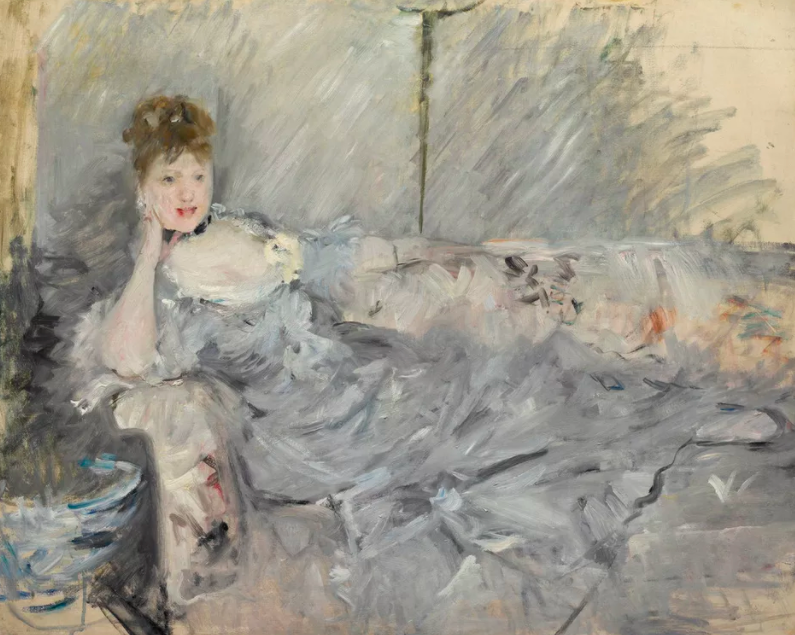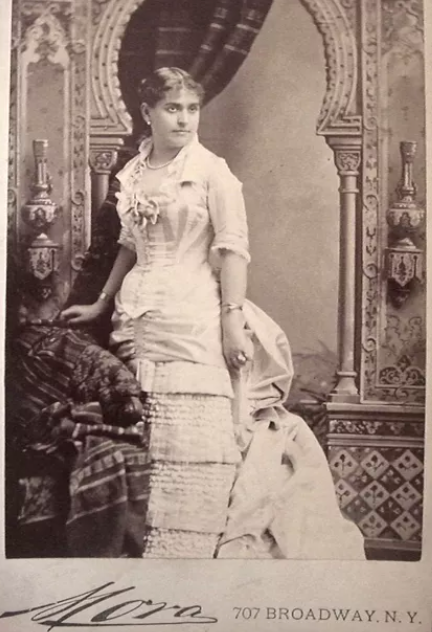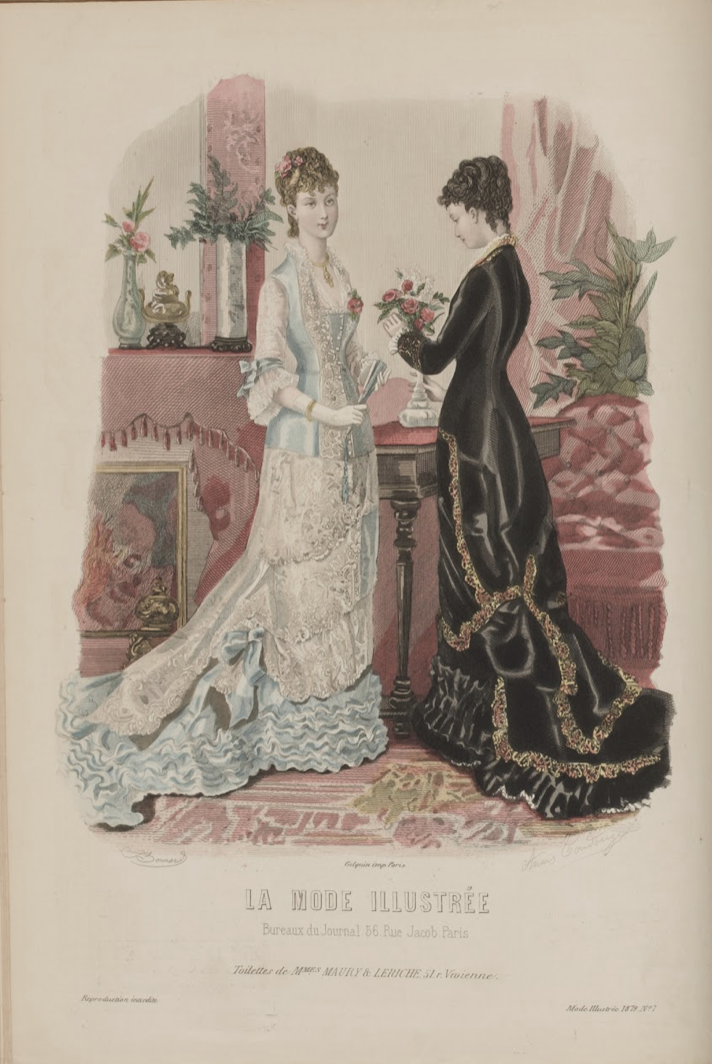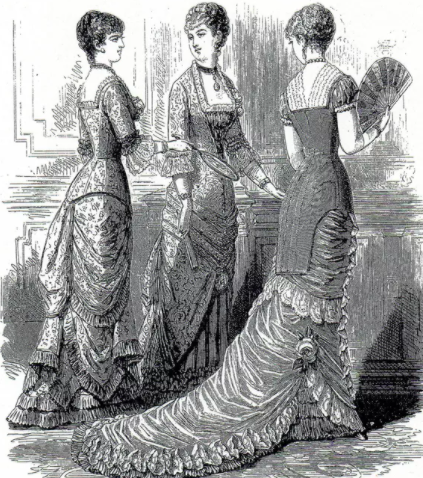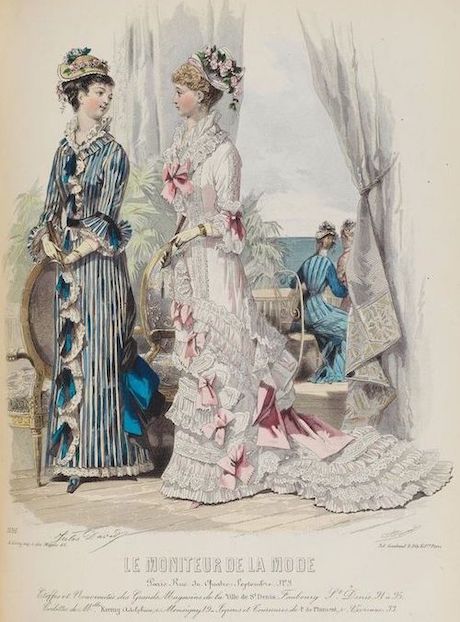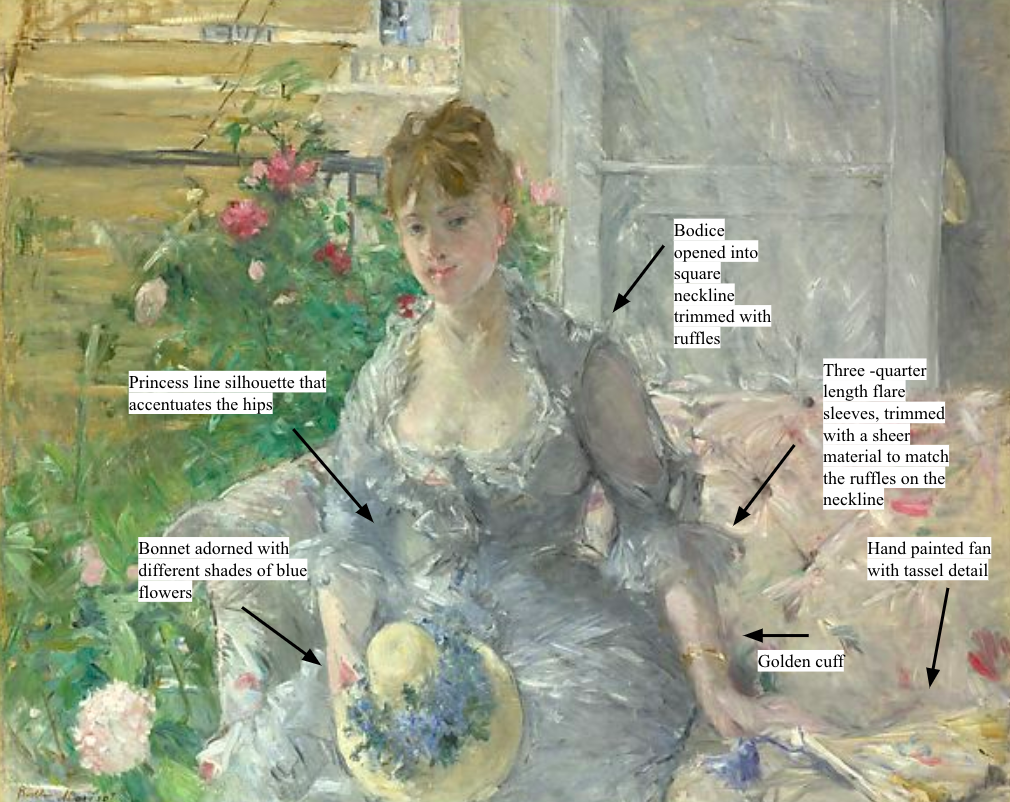Young Woman Seated on a Sofa by Berthe Morisot utilizes a light color palette and whimsical brushstrokes to create an elegant representation of the modern, bourgeois Parisienne. The painter brings elements of nature into an airy apartment setting to emphasize the beauty of her subject. In depicting the upper class woman, Morisot takes care to use fashionable elements that would be admired by those in high society, captivated by symbols of traditional femininity.
About the Portrait
Young Woman Seated on a Sofa was created by artist Berthe Morisot in 1841. Morisot was provided with a formal education throughout her childhood with the hope of later becoming an amateur artist (Garb 2003). She took drawing lessons and later, along with her sister, studied under many popular artists of the 1850s and 1860s. Anne Higonnet notes in her biography of Morisot that the painter’s sister, Lydia, acted as her main companion and inspiration growing up (9). They shared a strong commitment to developing their artistic skillset.
Fig. 1 - Berthe Morisot (French, 1841-1895). Woman in Grey Reclining, 1879. Oil on canvas; 60 x 73 cm. Paris: Private Collection. Source: Musée national des beaux-arts du Québec
After experimenting with a variety of mediums, Morisot concluded that her interests most aligned with painting the outdoors — known as en plein air (Adler and Garb 45). In her later works, Morisot frequently incorporated elements of nature into portraiture.
Morisot exhibited in the Salon from 1864-1868 and was a part of the group of artists that initiated the Impressionist exhibitions in the 1870s and 1880s (Garb 2003). She was celebrated as one of the group’s “most instrumental members, both in the creation of its aesthetic as well as the organization of its exhibitions” (Myers 2008). Morisot submitted works to all but one of these exhibitions, which she missed due to an illness directly following the birth of her daughter in 1878. Young Woman Seated on a Sofa was created in 1879 during her period of absence. The piece was later displayed in an 1895 exhibition hosted by the Woman’s Art Club in New York (The Met 2022). At the time, it was shown under the name “Jeune Femme Assise”, but other variations of this title included “Intérieur,” “Jeune Fille Assise,” “Femme assise devant une fenêtre,” “Portrait of a Young Woman Seated,” and “Jeune femme assise sur un canapé” (The Met 2022).
Art historian Nicole Myers explains how the depiction of the “modern woman” was the most common in the artist’s oeuvre — describing Morisot’s subjects as a representation of “the epitome of the grace and charm associated with the modern Parisian” (Myers 2018, 77). The sitter in Young Woman Seated on a Sofa not only demonstrates the poise referenced in Myers’ essay, but is a model Morisot continually used. The sitter can also be seen in a similar painting, Woman in Grey Reclining (Fig. 1), with bolder brushstrokes that give the piece a more sketch-like feel. In this artwork, she is wearing the same dress in Young Woman Seated on a Sofa, suggesting it might have been a favorite of either the model or artist.
Berthe Morisot (French, 1841–1895). Young Woman Seated on a Sofa, 1879. Oil on canvas; 80.6 x 99.7 cm (31 3/4 x 39 1/4 in). New York: The Metropolitan Museum of Art, 1992.103.2. Partial and Promised Gift of Mr. and Mrs. Douglas Dillon, 1992. Source: The Met
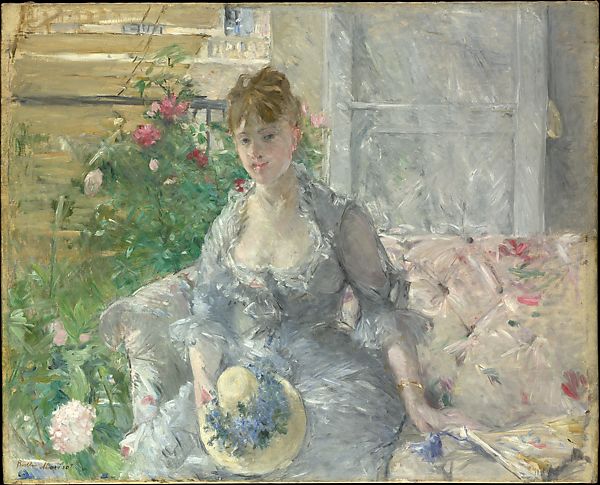
About the Fashion
The light grey dress, paired with subtle blue tones, features sheer three-quarter length flared sleeves that include a ribbon detail. The sleeve embellishment is also used at the garment’s collar, providing an eye-catching ruffled trim. In her lap the model holds a hat adorned with vivid blue flowers. A fan in spring pastel colors that closely match the sofa and the delicately painted hydrangeas rests near her left hand. Harper’s Bazar in February of 1879, the same year as the painting, introduces the desired spring colors:
“The new blues are called faience blue and Sevrés blue, comprising many pale and dark shades of pure tone, while the new iceberg blue may be classed with green as well; there are also turquoise, peacock, and sapphire blues.” (119)
This trend is reflected in the the different shades of blue flowers on the model’s bonnet. Proper color selection for accessories was crucial in finalizing an ensemble and they act as key indicators of the time period.
The aforementioned ruffled collar and three-quarter length sleeves were popular styles of the late nineteenth century. In a photograph of opera singer Adelina Patti, taken in the 1870s (Fig. 2), an almost identical collar and sleeve style is shown. Patti is also posing with a fan in hand that includes an attached tassel, similar to the one held by Morisot’s model in Young Woman Seated on a Sofa. Another well-known opera singer of the time, Anna de Belocca, was photographed in 1879 also in a similar look (Fig. 3). Both photographs display fashion comparable in style to the painting, with the singers presented with matching hairstyles and golden cuff bracelets that resemble the one in the painting.
Morisot paints a dress with what appears to be a sheer silk material for the arm of the sleeves, as well as the trim. The use of this material is also incorporated into the garments seen in both the portraits and the 1879 fashion plate published by La Mode illustrée (Fig. 4). The plate also features a square neckline and ribbon detailing on the flared sleeves, demonstrating the popularity of each of these components. A fashion plate published by Revue de la mode in 1880 (Fig. 5) illustrates dresses incorporating these same elements and includes one with a the tighter silhouette, otherwise known as a princess line. The garment could have been mostly machine-sewn, but it is likely the trims, including the lining of the collar and the flared sleeves, were added by hand. Similarities between the fashion plates, photographs and the painting argue in favor of the garment’s fashionability and the relevance of its coordinated accessories.
Fig. 2 - Photographer unknown. Soprano Adelina Patti, 1870s. Source: Pinterest
Fig. 3 - Jose Maria Mora. Anne de Belocca, Opera Singer, 1879. Source: Pinterest
Fig. 4 - Adele-Anaïs Colin Toudouze (French, 1822-1899). La Mode illustrée, vol. 20, no. 1 (January 1879). Tokyo: Bunka Gakuen Library. Source: Bunka Gakuen Library
The addition of the straw bonnet (a similar style can be seen in figure 6) and the sleeve length of the dress, in Young Woman Seated on a Sofa, act as indicators for the context in which the garments may have been worn — a daytime social setting. In reference to the significance of the model’s bonnet, a New York Times article published in the spring of 1879 highlights the popularity of this accessory:
“Among the new Spring bonnets are numberless shapes. The Directoire style will again be worn, only wider than it has been, to protect from the heat of the sun. It will be trimmed with bouquets of many-colored flowers” (4).
Fig. 5 - Artist unknown. Revue de la mode, 1880. Source: Pinterest
Fig. 6 - Jules David (French, 1808-1892). Le Moniteur de la mode, 1878. Source: Pinterest
The setting also provides an idea of the time of day, as the sunlight comes through the open balcony doors. The inclusion of flowers give viewers the feeling of being immersed in nature, through the abundance of colorful blossoms and greenery. It can be assumed that a detachable fichu may have filled in the dress’ notably low neckline when worn outdoors. Morisot appears to capture the moments following the removal of the subject’s fichu, hat, gloves and parasol upon returning to a private interior. These accessorizes would have been essential for appropriate late 19th-century daytime outdoor attire. The model’s flushed cheeks perhaps also suggest recent physical exertion, i.e. walking. Overall, it can be concluded, with the support of the fashion plates and photographs, that the woman was on trend for the late 1870s. With Morisot’s focus on depicting elegant, upper middle-class women, we understand that the model is meant to portray a figure with a strong concern with fashionable dress who has perhaps just returned from a stroll out-of-doors.
Diagram of referenced dress features.
Source: Kennedie O’Byrne
References:
- Adler, Kathleen. and Tamar Garb. Berthe Morisot. London: Phaidon Press. 1987. http://www.worldcat.org/oclc/878701044
- Garb, Tamar. “Morisot, Berthe (-Marie-Pauline).” Grove Art Online. 2003. Accessed May 12, 2022. https://www-oxfordartonline-com.libproxy.fitsuny.edu/groveart/view/10.1093/gao/9781884446054.001.0001/oao-9781884446054-e-7000059646.
- Higonnet, Anne. Berthe Morisot. 1st ed. New York: Harper & Row, 1990. http://www.worldcat.org/oclc/832217337
- Myers, Nicole R. “‘Extreme Novelty or Things of the Past: Morisot and the Modern Woman.” in Berthe Morisot : Woman Impressionist. edited by Sylvie Patry, Cindy Kang. Marianne Mathieu. Bill Scott. and Damion Searls. New York: Rizzoli Electa. 2018. http://www.worldcat.org/oclc/1027042476
- Myers, Nicole R. “Women Artists in Nineteenth-Century France.” The Metropolitan Museum of Art. 2008. https://www.metmuseum.org/toah/hd/19wa/hd_19wa.htm.
- “New York Fashions: Spring Millinery.” Harper’s Bazar. February 22, 1879. 119. https://www.proquest.com/magazines/new-york-fashions/docview/1850139920/se-2?accountid=27253.
- “The Fashions.” New York Times (1857-1922). March 30, 1879. 4. https://www.proquest.com/historical-newspapers/fashions/docview/93800995/se-2?accountid=27253.
- “Young Woman Seated on a Sofa.” The Metropolitan Museum of Art. 2022. https://www.metmuseum.org/art/collection/search/437160.


